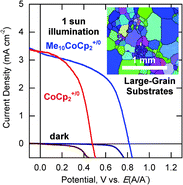820 mV open-circuit voltages from Cu2O/CH3CN junctions†
Abstract
P-Type cuprous oxide (Cu2O) photoelectrodes prepared by the thermal oxidation of Cu foils exhibited open-circuit voltages in excess of 800 mV in nonaqueous regenerative photoelectrochemical cells. In contact with the decamethylcobaltocene+/0 (Me10CoCp2+/0) redox couple, cuprous oxide yielded open-circuit voltage, Voc, values of 820 mV and short-circuit current density, Jsc, values of 3.1 mA cm−2 under simulated air mass 1.5 illumination. The energy-conversion efficiency of 1.5% was limited by solution absorption and optical reflection losses that reduced the short-circuit photocurrent density. Spectral response measurements demonstrated that the internal quantum yield approached unity in the 400–500 nm spectral range, but poor red response, attributable to bulk recombination, lowered the overall efficiency of the cell. X-Ray photoelectron spectroscopy and


 Please wait while we load your content...
Please wait while we load your content...